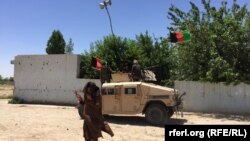LASHKAR GAH, Afghanistan -- Afghan forces are fighting only a few kilometers from the center of Lashkar Gah, capital of the restive southern province of Helmand.
With the aid of fresh reinforcements and U.S. airstrikes, they are engaged in what looks like the last stand to defend the beleaguered provincial capital against the Taliban, who have overrun most of Helmand’s nearly 60,000 square kilometers over the past 18 months.
Both Helmand residents and lawmakers blame the failures of the Afghan government for allowing the Taliban to move from remote desert hideouts and reclaim Afghanistan’s largest province.
Helmand’s status as the global epicenter of opium production and the narcotics trade has served a lynchpin for the hard-line Taliban regime in the 1990s.
Already a major revenue source for the insurgents, control over Helmand will not only give the Taliban a deciding stake in the region’s drug trade but also give them a major propaganda boost.
Bashir Ahmad Shakir, a member of Helmand’s provincial council, said government weaknesses helped the Taliban to make a comeback in Helmand after being ousted from power in late 2001.
He said Afghan forces failed to reverse a major Taliban offensive last year that was aimed at controlling Helmand’s northern districts.
“If we had successfully defended our northern districts [last year], we wouldn’t now be facing the enemy in [Lashkar Gah’s] fourth district, Babaji,” he said. “Fighting in the remote districts should have been dealt with as eventually posing a challenge to the security of our provincial capital.”
Media reports citing internal Afghan government communications suggest the Taliban now control or contest 12 of Helmand’s 14 districts.
After capturing the districts of Nawzad and Musa Qala late last year and overrunning large swathes of the neighboring districts in northern Helmand, the Taliban turned their attention to districts in central Helmand in an apparent attempt to tighten the noose around Lashkar Gah.
The Taliban ‘Red Brigade’ is credited with swift advances this month. The insurgents overran most of Nad-e Ali and Nawa-e Barakzai districts and cut off the main road connecting the provincial capital to the rest of the country, positioning themselves to overtake the city.
They appear bent on repeating their short-lived capture of the northern Kunduz city last September.
Shakir said that after the departure of tens of thousands of foreign forces from Helmand as part of the end of NATO’s major combat operations in late 2014, Afghan authorities have failed to address the Taliban threat.
“I think they understood the gravity of the situation but failed to mobilize resources and make the right decisions at the right time,” he said.
Since January 2015, more than 30,000 Afghan Army and police soldiers have moved into some 180 outposts, small and large military camps previously manned by NATO forces.
But their strength mattered on paper only. On the ground, they were unable to stop the Taliban from returning or defend Helmand’s nearly 170 kilometer border with Pakistan, where the Taliban had found a safe haven. The Afghan forces were plagued by graft and a lack of coordination and professional leadership.
Kabul attempted to address these issues last year by appointing new military and political leaders to the province. But they too have apparently failed to stem the Taliban tide. Hundreds of Western military trainers have returned to Helmand, but reorienting thousands of Afghan troops amid fighting has so far failed to give the Afghan forces an upper hand.
Majid Akhundzada, deputy leader of Helmand’s provincial council, however, said the Taliban are desperate to set up their new headquarters in Helmand.
“The Taliban want to move their leadership from [the city of] Quetta in Pakistan to Musa Qala in Helmand,” he said. “This is why they are bent on securing the whole region before making the move.”
Over the past 14 years, Helmand has perhaps seen more combat than anywhere else in Afghanistan. More Western troops were killed here than in any other province.
The international military presence, however, failed to deliver sustainable stability because most insurgent leaders lived in Pakistan’s southwestern Balochistan Province. In late May, former Taliban leader Mullah Akhtar Mohammad Mansur was killed in a remote Balochistan road after returning from Iran.
His successor, Haibatullah Akhundzada, has reportedly united all of the Taliban factions in Helmand. He has also restored former Taliban military commander Mullah Abdul Qayyum Zakir, who hails from Helmand, to his post. Zakir’s reconciliation with the insurgent leaders has also boosted the Taliban campaign.
Helmand Governor Hayatullah Hayat said there is no immediate danger of the province falling to the Taliban. He did, however, acknowledge that, like the government, Helmand is of vital strategic significance for the Taliban, which heightens its appeal to the insurgents.
“The fall of Helmand will resonate strongly in Kabul and beyond in the northern provinces,” he said.
Abubakar Siddique wrote this story based on Mohammad Ilyas Dayee's reporting from Lashkar Gah, Helmand.






